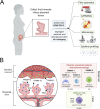Gatekeepers of the fetus: Characterization of placental macrophages
- PMID: 33601417
- PMCID: PMC7754679
- DOI: 10.1084/jem.20202071
Gatekeepers of the fetus: Characterization of placental macrophages
Abstract
In this issue of JEM, Thomas et al. (https://doi.org/10.1084/jem.20200891) provide elegant technological and conceptual advances that further our understanding of the immune cells enriched at the maternal-fetal interface. Using new isolation strategies to better separate maternal- and fetal-derived cells, the authors identify previously undefined maternal-derived immune cells associated with the fetal-derived placenta and provide an in-depth analysis of the markers and characteristics of placental Hofbauer cells.
© 2020 Megli and Coyne.
Figures


Comment on
-
Phenotypic and functional characterization of first-trimester human placental macrophages, Hofbauer cells.J Exp Med. 2021 Jan 4;218(1):e20200891. doi: 10.1084/jem.20200891. J Exp Med. 2021. PMID: 33075123 Free PMC article. Clinical Trial.
References
Publication types
MeSH terms
Grants and funding
LinkOut - more resources
Full Text Sources
Other Literature Sources

